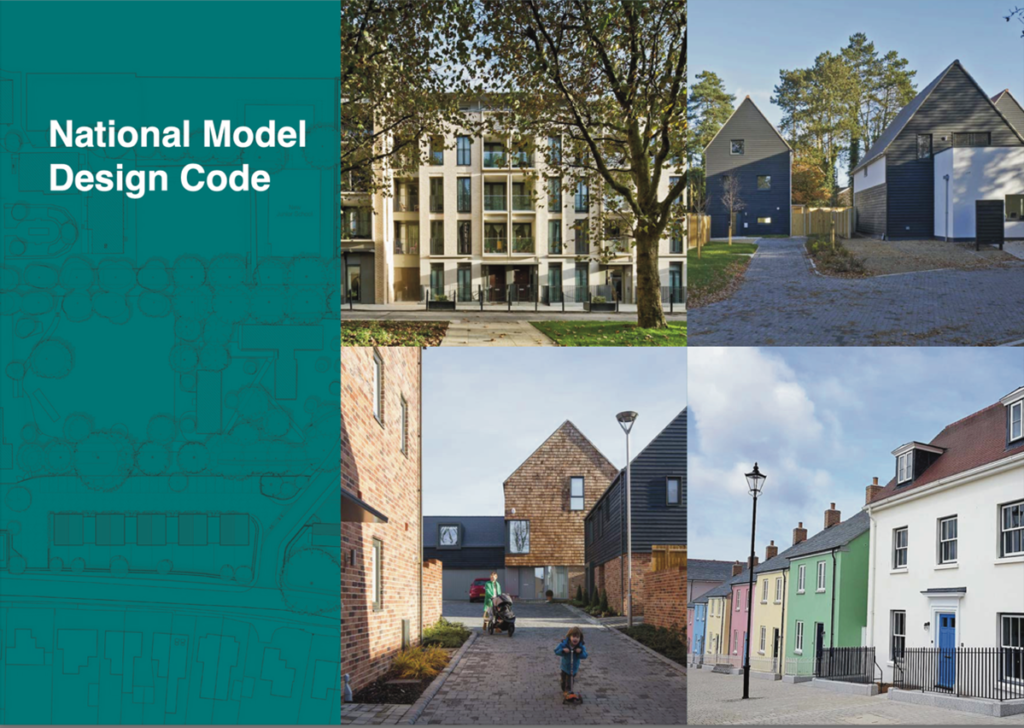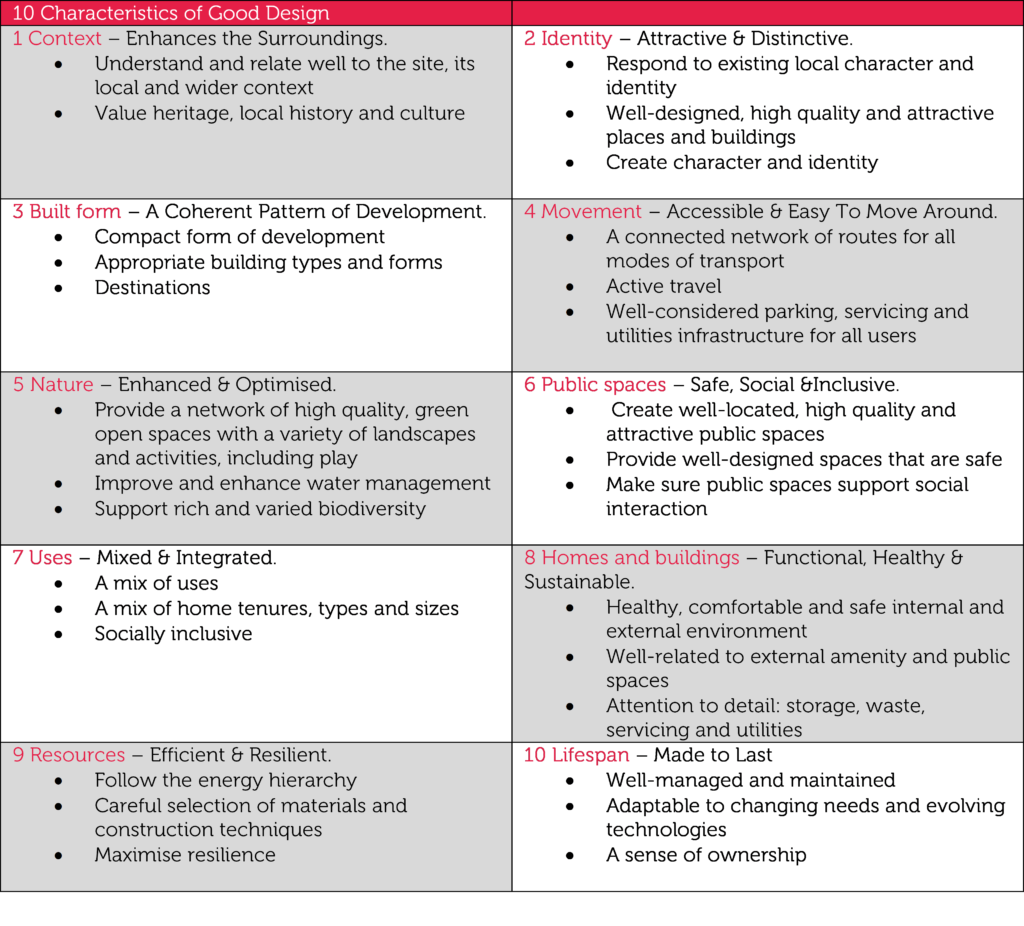Building beautiful places….Ministerial Statements, NPPF Changes & National Model Design Code

by Jo Hanslip
In his Ministerial Statement of 20 July 2021, Housing Secretary Robert Jenrick MP, launched the revised National Planning Policy Framework NPPF_July_2021 and the new National Model Design Code National_Model_Design_Code stating that beauty and design for the first time, will be at the ‘heart of the local planning system’.
The policy changes in the NPPF, seek “to create buildings that fit in with places, while maintaining the Framework’s existing strong focus on delivering the homes and other development which communities need. The changes:
- Make beauty and place-making a strategic theme
- Set out the expectation that local authorities produce their own design codes and guides setting out design principles which new development in their areas should reflect
- Ask for new streets to be tree-lined
- Improve biodiversity and access to nature through design
- Put an emphasis on approving good design as well as refusing poor quality schemes”
Most specifically in achieving these objectives:
- Paragraph 8b – includes reference to ‘well designed, beautiful and safe places’ – beautiful is as yet undefined and may result in much debate in the planning profession ….and courts….
- Paragraph 11a – Climate change, looking at natural management measures to flood risk reduce risk
- Paragraph 54 – update on the use of Article 4 Directions and extent and justification for their application to avoid ‘wholly unacceptable adverse impacts’
- Paragraph 128 – All local authorities to provide clarity on design expectation and prepare design guides or codes
- Paragraph 131 – tree lined new streets
- Paragraph 133 – a new test for development to be well designed and refused where it is not
- Paragraph 134 – significant weight to be given to design which reflects local policies and “outstanding or innovative designs which promote high levels of sustainability, or help raise the standard of design more generally in an area“.
- Changes in relation to flood risk
- Ensuring the historic and social significance of statues, monuments and memorials is fully explained
- and “an expectation that local planning authorities take a proactive approach to engaging with key delivery bodies and other stakeholders at the pre-application stage of local plan making”

Figure 1. National Model Design Code
The National Model Design Code (NMDC) National_Model_Design_Code expands upon the 10 characteristics of good design (as set out in the National Design Guide National_design_guide and as detailed below) and forms part of the Government’s planning practice guidance. It inevitably responds to the findings of the ‘Building Better, Building Beautiful Commission’ and provides details on the Coding Process including:
- Analysis
1A – Scoping: Agreeing on the geographical area to be covered by the code and the policy areas that it will address.
1B – Baseline: Bringing together the analysis that will underpin the code and inform its contents.

Figure 2: Design Code Process
- Vision
2A – Design Vision: Dividing the area covered by the code into a set of typical ‘area types’ and deciding on a vision for each of these area types.
2B – Coding Plan: Preparing a plan that maps out each of
the area types and also identifies large development sites from allocations in the local plan.
2C – Masterplanning: On larger sites working with land owners and developers to agree a masterplan for each of the development sites establishing the key parameters and area types.
- Code
3A – Area Type Guidance: Developing guidance for each area type by adjusting a set of design parameters.
3B – Design Code Wide Guidance: Agree on a set of policies that will apply equally across all area types.
The NMDC is identified to be a ‘toolkit’ for LPA’s on design parameters that need to be considered when producing design codes and guides. It should be noted that consultation is an element integrated at each stage of the coding process.
The MS indicates that
“Design codes are important because they provide a framework for creating healthy, environmentally responsive and sustainable places, with a consistent and high-quality standard of design. This will provide greater certainty for communities about the design of development and bring conversations about design to the start of the planning process, rather than the end.”
For reference, the 10 characteristics of good design as set out in the National Design Guide National_design_guide include:

Figure 2: National Design Centre

Within MCLG, an ‘Office for Place’ https://www.gov.uk/government/groups/office-for-place has been established which will be Chaired by Nicholas Boys Smith (Director of Create Streets social enterprise and former Chairman of the Building Better, Building Beautiful Commission) to help LPA’s across England create user friendly but effective design codes for their communities. 14 pilot authorities are currently trialling the new approach. The focus of the Office for Place has been identified by the Chair as being researching supporting/accrediting, training celebrating and advising….the first task being researching what people value and like….
Whilst a worthy objective, the new guidance puts further burdens on in many instances financially constrained and resource strapped Local Planning Authorities by
- Increasing expectations of LPA’s to prepare Design Guides or Codes
- Increasing expectations of LPA’s to ensure effective consultation with local communities on the preparation of such documents
- Providing opportunities for much ‘debate’ regarding what is ‘beautiful’ in a local context providing much scope for discussion between planning professionals, local members, local people and perhaps the courts in the fullness of time….
It will be interesting to see how ‘beauty’ is interpreted at a local level and manifested by the ‘the eye of the beholder‘ in taking planning decisions…..let’s hope it is route for positive change and not a cause for further prevarication and log jams in the system…..





